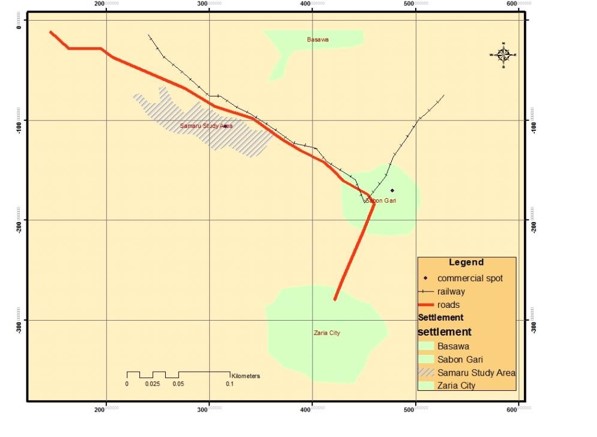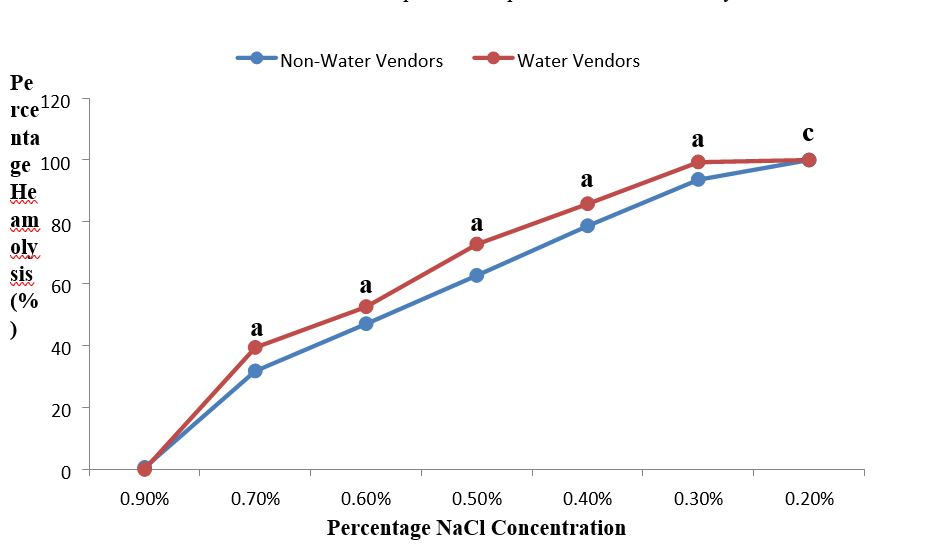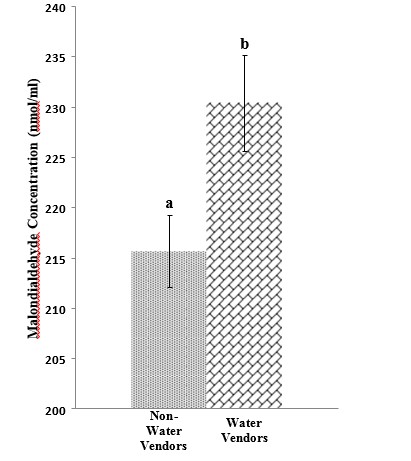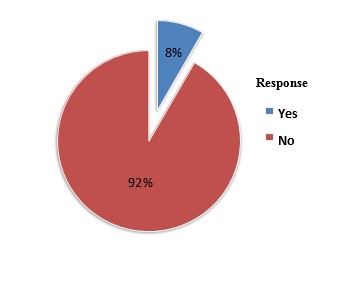Journal of Biomarker Research and Studies
Research Article
Erythrocyte Osmotic Fragility and Malondialdehyde Concentrations of Water Truck Pushers in Samaru, Sabon-Gari Local Government Area of Kaduna State, Nigeria
Usman D1*, Jimoh A1, Gidado NM1, Balogun JB2, Tanko Y1, Ahmed A3, Mohammed A1 and Ayo OJ4
1Department of Human Physiology, Ahmadu Bello University, Zaria, Nigeria
2Department of Biological Sciences, Federal University Dutse, Jigawa State, Nigeria
3Department of Pharmacognosy and Drug Development, Ahmadu Bello University, Zaria, Nigeria
4Department of Veterinary Physiology, Ahmadu Bello University, Zaria, Nigeria
*Corresponding author: Usman D, Department of Human Physiology, Ahmadu Bello University, Zaria, Nigeria. Tel: +23407067430505; Email: dawoudusman6@gmail.com
Citation: Usman D, Jimoh A, Gidado NM, Balogun JB, Tanko Y, et al. (2019) Erythrocyte Osmotic Fragility and Malondialdehyde Concentrations of Water Truck Pushers in Samaru, Sabon-Gari Local Government Area of Kaduna State, Nigeria. J Biomark Res Stud: JBRS-100001.
Received date: 17 August, 2019; Accepted date: 05 September, 2019; Published date: 10 September, 2019
Abstract
Water vending is a significantly lucrative business laden with stressful and strenuous activities making it to be implicated in oxidative damage, lipid peroxidation and the susceptibility of erythrocytes to haemolysis. The study was designed to investigate the degree of erythrocyte osmotic fragility (EOF) and Malondialdehyde (MDA) concentrations among water vendors and non-water vendors. Copies of questionnaire were randomly distributed in the study area to a total of 192 subjects of which water truck pushers (experimental group) were 96 and non-water truck pusher (Control group) were also 96 individuals. 5ml of blood was obtained from the median cubital vein via venepuncture. Ethical clearance was obtained from the health research ethics committee of A.B.U, Zaria, Nigeria. 3ml of samples stored in EDTA bottles were used for EOF whereas serum samples obtained from 2ml of centrifuged blood were assayed biochemically for MDA concentration using TBARS assay. Data obtained were analysed using independent sample T-test and cross Tab for descriptive statistics. The result showed a significant (P < 0.05) increase in serum MDA concentrations of the experimental group as compared to controls with a value of 230.33 ± 4.75 compared to 215.61 ± 3.59 nmols/mL respectively. EOF of water vendors showed significant (P < 0.05) increase with a value of 85.83 ± 0.37% when compared to 78.69 ± 0.53% for non-water truck pushers at 0.4% concentration of NaCl solution. These findings suggest that a significant increase exists in the EOF and MDA concentration of water vendors and as such the need to mitigate this effect.
Keywords: Erythrocyte osmotic fragility; Ergonomics; Lipid peroxidation; Oxidative stress; Water vendors
Introduction
Water remains one of the cardinal requirements to sustain life demanded for both domestic and non-domestic purposes. The WHO/UNICEF describes reasonable access to water as being “the availability of at least 20 litres per person per day from a source within one kilometre of the users dwelling”. However, one-sixth of humanity (1.1 billion people) lack access to any form of improved water and only 61% of the sub Saharan population have easy access to improved water sources [1-5]. 65 million Nigerians have no access to safe water and with the inadequacy of pipe-borne water being a growing problem, individuals are compelled and resort to buying water from vendors.
Water vendors/water truck pushers constitute a group of distributive or ambulatory vendors also known as pushcart vendors, that supply water in jerrycans to customers at their doorsteps or at the street corner using metal pushcarts designed for this purpose by local blacksmiths. They are commonly called mai ruwa (water men) or mai kura (truck pushers) in the Hausa dialect. Water vending is proving to be a rapidly expanding source of employment for individuals, associated with prolonged physical stress and physically strenuous activity due to its demand-driven nature.
Almost all studies on them (the world over) show that they work for long hours and under trying conditions. Looking at water vending from an ergonomic and kinesiology perspective, truck pushing involves both upper and lower body exercise. Such exercise in heat, as compared with a neutral environment, causes many physiologic changes in the dynamics of the human body and can overload the body’s ability to properly respond to the imposed stress, which can result in hyperthermia, dehydration, deteriorated physical and mental performance, and a potentially serious (even fatal) exertion heat illness. Stress and Strenuous physical activity have been implicated in oxidative damage, lipid peroxidation and osmotic fragility [6-10].
Stress has been associated with the pathomechanisms of different diseases, and redox processes are believed to play a major role in its generation, defence and signalling, exerts that exposure to strenuous activities results in marked elevations of oxidative stress. Strenuous physical activity increases oxygen consumption and increases the concentrations of free radicals, which if severe can cause damage to the cells (by inducing oxidative stress) and when mild has a regulatory function due to the activation of antioxidant enzymes, thus offering antioxidative protection.
This research evaluates the extent of erythrocyte osmotic fragility (OST) and Malondialdehyde (MDA) concentrations of water vendors in Samaru, Sabon-Gari local government area of Kaduna State, Nigeria. With the goal of getting baseline values for water vendors, to enable accurate interpretation of clinical values in the management of diseases affecting water vendors, to deepen current knowledge on mechanisms by which cells respond to strenuous occupational activity and to provide clues for further understanding strenuous occupational activities. This might also help in the evaluation of the opinion on antioxidant supplementation during exercise and strenuous physical activity [11-15].
Materials and Methods
A case-control study of 192 randomly selected subjects (96 water vendors and 96 non-water vendors) was adopted for this evaluation. Apparently healthy water vendors with at least 1 year of working experience were mobilised during a one-month follow-up period. Data were obtained via detailed interviews, administration of questionnaires and field experimentation. While 5ml collected blood samples were used for in-vitro experimental analysis/assay in the laboratory. The study protocol was approved by the Health Research Ethics Committee of Ahmadu Bello University Teaching Hospital (ABUTH) (ABUTH/HREC/UG/6) and all participants signed a written consent form. Subjects showing evidence of target-organ-damage were excluded from the study. An exclusion criterion for alcohol usage, pretest exercise and prandial pre-test conditions was observed using a selection protocol consisting of clinical history, physical examination and appropriate tests [16-20].
Study location: Samaru is found in Sabon Gari LGA located between Ahmadu Bello University, Basawa and Bomo. It is a growing urban settlement within Zaria located approximately between latitudes 110 10` and 11011` N of the Greenwich Meridian and longitude 70 37’ and 70 40’ E of the Equator in the fringes of the Northern Guinea Savannah (Figure 1) and having an estimated population of 343,000. It is a combination of residential and commercial areas, with many ethnic groups, major ones include Hausa, Fulani, Yoruba, Igbo, Ebira, Idoma etcetera. There is a strong presence of educational institutions in the district with primary, secondary as well as tertiary institutions located in the area [21-25].
Experimental procedure and Blood analysis: The subjects were introduced to completion of questionnaire and the average weights of trucks and jerry cans were obtained. Measurements were done using Suspended weighing balance (Model 235, TL Weigh, 200kg × 1kg, Made in England) at Badamasi Iron Store, Daraka, Samaru. 150 microliters (0.15ml) of serum samples obtained from centrifuged (Bench Centrifuge, Batch No. 68/3.856/253, Baird and Tatlock Ltd., England) blood were used to determine the serum MDA level via Thiobarbituric Acid Reactive Substance (TBARS) assay using the modified method. The resulting pink solutions were then transferred into cuvettes and placed in a spectrophotometer (Spectrumlab 22PC, Batch No. 22PC08211) to determine the absorbance at wavelength of 535nm and the malondialdehyde formed was then calculated using the molar extinction coefficient of 1.56 × 10-5 cm-1M-1. MDA concentration=absorbance of sample/ 1.56 × 10-5 cm-1M-1. The erythrocyte osmotic fragility was determined using the method described by 0.05ml of anticoagulated blood (in EDTA bottles) was added into 5ml of solutions with decreasing strengths of hypotonic saline. Gently mixed and allowed to stand for 5 mins and the centrifuged for 3 minutes. The supernatant solution was read using a colorimeter (Optima, Japan) at a wavelength of 540nm. The percentage haemolysis was calculated using the formula described (Optical density of test /Optical density of distilled water) × 100 = Percent haemolysis of each sample at different saline concentration.
Statistical analysis: An Independent Samples T-test was conducted to obtain the mean ± the standard error of mean (SEM) while Cross tabulations were used as inferential nonparametric test The analysis was carried out using Statistical Package for Social Sciences (SPSS software version 20; SPSS Inc., Chicago) and Microsoft Excel ©2010. Values of P < 0.05 were considered significant [21-25].
Results Effect of water vending on the erythrocyte osmotic fragility
The experimental group of water truck pushers show an extremely significant (P<0.001) increase in the degree of haemolysis compared to the control group of non-water truck pushers with average values of 39.40 ± 0.65% haemolysis for experimental group and 31.81 ± 0.39% haemolysis for the controls at 0.7% NaCl Concentration, 52.56 ± 0.66% haemolysis for the experimental group and 47.04 ± 0.44% haemolysis for the control group at 0.6% NaCl Concentration, 72.81 ± 0.65% haemolysis for the experimental group and 62.67 ± 0.53% haemolysis for the control group at 0.5% NaCl Concentration, 85.83 ± 0.37% haemolysis for the experimental group and 78.69 ± 0.53% haemolysis for the control group at 0.4% NaCl Concentration and 99.33 ± 0.17% haemolysis for the experimental group and 93.67 ± 0.39% haemolysis for the control group at 0.3% NaCl Concentration respectively. Complete haemolysis (100.00 ± 0.00%) was observed for both groups at 0.2% NaCl Concentration. No significant degree of haemolysis (P>0.05) was observed between the groups at 0.9% NaCl Concentration [26-30] (Table 1).
Effect of water vending on malondialdehyde concentrations The experimental group (water truck pushers) show a very highly significant (P<0.001) increase in the serum concentration of malondialdehyde with a value of 230.33 ± 9.57 nmols/ml of plasma as compared to the control group (nonwater truck pushers) with a value of 215.61 ± 7.24 nmols/ml of plasma, respectively (Table2) (Figure 2 & Figure 3).
Result from field measurements the average dry weight of one truck was found to be 47kg, while the average weight of one empty 25 litre water jerrycan was also measured to be 1kg and average weight of a 25 litre jerrycan full of water was 25kg.
Result of Questionnaire Study After collation of survey questionnaires, data entry and analysis were performed and a frequency table was developed for the sample population. As seen below. Has anyone interviewed you about truck pushing? (Table 3) (Figure 4).
Discussion
Result from osmotic fragility of water vendors indicate a significant (P < 0.05) increase in erythrocyte haemolysis as compared to that of non-water vendors. This result is in agreement with research conducted and described by [26], who reported a significant increase in the erythrocyte osmotic fragility of medium level trained athletes, one hour after submaximal exercise (i.e. after running 5000metres in 16minutes) and [27], who reported increased haemolysis in rabbits subjected to road transportation (for 2 h under hot-humid climate). The increased erythrocyte osmotic fragility as observed in the present study implies that water vending increases haemolysis which is evident from the strenuous occupational activity. This agrees with the findings of [28], who showed that physical exertion increases haemolysis in donkeys and [29], reported a significant increase in the erythrocyte osmotic fragility of one-humped camels subjected to packing and trekking, with bags grains of 200 kg (which are half the body weight of each camel) for 10km. This further confirms the theory that exposure to oxidative stress increases haemolysis due to the altered mechanical properties of erythrocytes, as reported by [30]. A single bout of strenuous activity often leads to an acute oxidative stress, which may result in an increased level of oxidized molecules and macromolecules [31-35]. However, factors such as intensity, duration and the subject’s individual (genetic and physical) characteristics may impact the degree of oxidation [36-40]. This phenomenon of increased membrane fragility could probably result from the extensive degree of strenuous physical activity associated with vending which triggers the development of oxidant species. Increased oxidized glutathione levels occasioned by the deficiency of reduced glutathione antioxidant in the pentose phosphate pathway/hexose monophosphate shunt could be triggered by insufficient nutrient substrate (Id est. glucose). Apparently, the oxidized glutathione (an oxidant) then acts by degrading membrane proteins and producing increasing degree membrane lipid per oxidization, an underlying cause for haemolysis [41-45]. Thus, upon further oxidative or osmotic stress, the membranes of erythrocytes lose their resilience and lyse, releasing their contents, which is then evident in serum as an increased optical density/absorption. Lipid peroxidation in the erythrocytes membrane could also result from increased production of superoxide from the respiratory chain and from membrane xanthine oxidase, which is triggered by increased consumption of oxygen during physical activity demonstrated that the oxidative stress was reduced in cyclers who were taking the xanthine oxidase inhibitor allopurinol [46-50].
The extensive degree of strenuous physical activity associated with water vending may be a consequence of the fact that most water vendors (83.3%) carry between 1115 of 25 litre jerry cans, 7-9 times a day, for an average period of about 10-12 hours per day (from dawn till dusk). This is usually along bad roads that are difficult to trespass and for long distances. Given that each jerry can of water (25 litre) weighs about 25kg, a vendor (averagely weighing 70kg) carrying 14 jerry cans will be pushing on average 350 kg of water (14 × 25kg) plus an additional truck weight of 47kg; giving a total net weight of approximately 400kg (about 6 times his weight) from probably 7am to 6pm (11hrs). The increased demand for their services is another likely contributor, with 66.7% reportedly selling a truck of water within the hour of procurement. Increase in the serum malondialdehyde concentration of water vendors as compared to non-water vendors is indicative of an increased lipid peroxidation in the erythrocyte membrane of water vendors and is confirmed by the increased osmotic fragility in our result. This finding is in consonance with report by who illustrated that the occurrence of oxidative stress is exemplified by increased MDA concentration [51-55], obtained a significant increase in the serum malondialdehyde concentration of camels subjected to packing. This finding also supports the earlier observation that increased MDA values can be due to stress [56-60].
The rise in MDA concentrations obtained in the present study suggests that lipid peroxidation is also initiated by strenuous activity. This effect was confirmed in the research [61-65], which showed that the serum MDA concentration increased significantly in donkeys subjected to physical exertion [66-69], also demonstrated a gradual rise in MDA concentrations of Rams subjected to the strain of road transport.
The rise in MDA concentrations obtained in the present study, is possibly due to the fact that lipid peroxidation, a well-established mechanism of cellular injury and a useful indirect indicator of oxidative stress [70] can be initiated by any chemical species such as oxidized glutathione which extracts a hydrogen atom from the side chain double bonds of a polyunsaturated fatty acid (PUFA) which is generally present in the cell membranes [71]. The probably increased oxidized glutathione level is an outcome from strenuous activity which results in the formation of lipid peroxides which are unstable compounds [72,73] that degrade rapidly into a variety of sub products, such as MDA [74,75]. Arachidonic acid is the polyunsaturated omega-6 fatty acid (a PUFA) present in the cell membranes, brain, muscles and liver that contains many uninterrupted methylene double bonds that serve as a source of hydrogen atoms for the free radicals [76].
The present study also shows that over half of the water vendors have suffered from joint pains and other ailments due to their profession. This might be a consequence of the deteriorative effect of oxidative stress and emphasizes the need to mitigate these effects. This research shows great potential as about 91.7% of vendors report to have never been interviewed and examined with regards to water vending [77,78].
Conclusion
In conclusion, the present study highlights observation that the oxidative and fragility parameters are significantly compromised during water vending in Samaru, North-western Nigeria. This is evident from the increased malondialdehyde concentration and high tendency to haemolysis of the red cell membrane in water truck pushers as compared to non-water truck pushers. Thus, drawing emphasis for the need to ameliorate the possible outcomes.

Figure 1: Sabon-Gari showing Samaru (Adopted from Benedine et al., 2011).

Figure 2: Erythrocyte osmotic fragility curve for the experimental and control groups. Superscript letter a indicates significant (P<0.05) haemolysis in water vendors as compared to controls (non-water vendors).Superscript c indicates complete haemolysis.

Figure 3: Showing the average serum Malondialdehyde concentrations for water vendors and non-water vendors. Different Superscript letters a, b indicate significant (P < 0.05) difference between groups.

Figure 4: Pie chart showing response to the questionnaire.
|
Group |
0.9% NS |
0.7% NS |
0.6% NS |
0.5% NS |
0.4% NS |
0.3% NS |
0.2% NS |
|
Non-Water Vendors |
0.58 ± 0.29 |
31.81 ± 0.39 |
47.04 ± 0.44 |
62.67 ± 0.53 |
78.69 ± 0.53 |
93.67 ± 0.39 |
100.00 ± 0.00 |
|
Water Vendors |
0.00 ± 0.00 |
39.40 ± 0.65* |
52.56 ± 0.66* |
72.81 ± 0.65* |
85.83 ± 0.37* |
99.33 ± 0.17* |
100.00 ± 0.00 |
|
P value |
0.155 |
0.000 |
0.000 |
0.000 |
0.000 |
0.000 |
-
|
|
Note:* = indicates significance (P < 0.05) in haemolysis of water vendors as compared to controls (non-water vendors). |
|||||||
Table 1: Result from Osmotic Fragility Test for water vendors and non-water vendors.
|
Group |
MDA (nmols/ml) |
|
Non-Water Vendors |
215.61 ± 3.59 |
|
Water Vendors |
230.33 ± 4.75* |
|
P value |
0.000 |
|
Note:* = indicates significance (P<0.05) of MDA concentrations in water vendors as compared to controls (nonwater vendors). Descriptive statistics for Malondialdehyde concentrations: from Cross-tabulation [X2 (Pearson Chi-Square)=180.000, df=0]. |
|
Table 2: Result obtained from Independent Samples Test for Malondialdehyde levels.
|
S/N |
Question |
Response |
Percentage (%) |
|
1 |
Have you ever suffered from any joint pain as a result of your work? |
Yes |
60.4 |
|
No |
39.6 |
||
|
2 |
Have you ever suffered from any other ailment due to your job? |
Yes |
54 |
|
No |
42 |
||
|
3 |
Does your job affect your health negatively? |
Yes |
50 |
|
No |
46 |
||
|
4 |
How long does it take you to sell one truck of water? |
Within an hour |
66.7 |
|
1-2hours |
31.3 |
||
|
2-3 hours |
2.1 |
||
|
5
|
What is the daily time duration of your work? |
1-3 hours |
2.1 |
|
4-6 hours |
10.4 |
||
|
7-9 hours |
12.5 |
||
|
10-12 hours |
58.3 |
||
|
13-15 hours |
16.7 |
||
|
6 |
How many containers do you operate with? |
6-10 Jerry cans |
2.1 |
|
11-15 Jerry cans |
83.3 |
||
|
16-20 Jerry cans |
8.3 |
||
|
21-25 Jerry cans |
2.1 |
||
|
26-30 Jerry cans |
2.1 |
||
|
7 |
What number of trucks do you sell in a day? |
1-3 trucks |
2.1 |
|
4-6 trucks |
39.6 |
||
|
7-9 trucks |
47.9 |
||
|
10-12 trucks |
8.3 |
||
|
8 |
Is there ever a period in which you do not work? |
Yes |
81.3 |
|
No |
18.8 |
Table 3: Showing some responses of water.
Citation: Usman D, Jimoh A, Gidado NM, Balogun JB, Tanko Y, et al. (2019) Erythrocyte Osmotic Fragility and Malondialdehyde Concentrations of Water Truck Pushers in Samaru, Sabon-Gari Local Government Area of Kaduna State, Nigeria. J Biomark Res Stud: JBRS-100001.